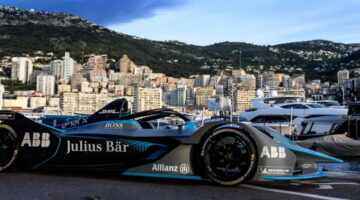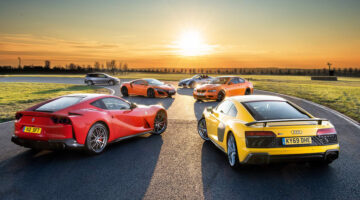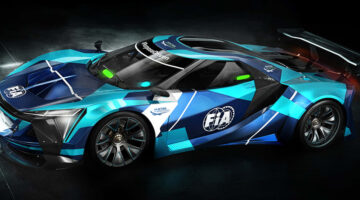Jaguar Racing launches its first ever Formula E single seater, the I-Type. But how will Jaguar’s return to motorsport impact the roadcar division?
—
Formula E, the FIA’s electric single seater racing series, is about to start its third season in Hong Kong. There were many who didn’t expect it to make it this far. Plenty of single seater ventures have been founded, failed to flourish, and quietly died away – just ask A1GP, Superleague or Formula 2.
But Formula E is going from strength to strength, and it’s attracting not just interest but full works entries from major manufacturers. The 2016/2017 season will see Panasonic Jaguar Racing join the fray, just as Audi plans to up its existing support of the ABT Schaeffler team to a full works effort from season four onwards. BMW and Volvo have also made noise about joining in alongside existing OEMs like Renault and DS (part of Citroen), and electric vehicle specialists like NextEV, Venturi and Faraday Future.
A large part of the reason for Formula E’s success is its relevance to the future of road cars. With the electrification of production vehicles expanding at a pace, a series that lets carmakers showcase their electrical expertise, and benefit from development that comes from competition, is proving attractive.
Jaguar’s Formula E entry – the launch of which crankandpiston.com attended in the UK – marks its first factory motorsport effort since it withdrew from Formula 1 in 2004. That 12-year gap shows it won’t just throw cash at racing for the sake of it – there has to be strong justification. Jaguar will be working with Williams Advanced Engineering – an offshoot of the F1 team of the same name – and is banking on Formula E becoming a significant tool for the development of future road cars.
“EV technologies are a major part of our future,” says Gerd Mäuser, Jaguar Land Rover’s chief marketing officer. “This programme will also generate tangible R&D benefits, with the technology developed and lessons learned from the race track helping to accelerate electrification for our future road vehicles.”
This concept is not new – in fact, it’s one that Jaguar has found great success with in the past. “In many ways, this goes back to a formula that proved so successful for Jaguar in the 1950s, when the legend of Jaguar was created with wins at Le Mans,” Mäuser says. “In those times, innovations such as disc brakes, the twin-cam XK engine and the lightweight monocoque chassis were all developed on the race track before being transferred to the road car division. Fast forward and you can see there is a strong parallel and opportunity for Jaguar’s Formula E programme to have an impact beyond the race track.”
Formula E as a series focuses particularly on electric powertrain development among teams, while bodywork and most other specifications are all set in stone by the regulations. According to JLR’s group engineering director Nick Rogers, this means that all of Jaguar Racing’s efforts are focused on the electric future rather than trying to eke out tenths of a second through a fancy new front wing. The resultant glamour of motorsport, he hopes, will inspire and motivate the 9000-strong workforce as JLR looks to focus on electrification.
“All of the technology, all of the control systems, the batteries, is being pushed to the limits while on the race track in very short cycles, and that absolutely will flow back into our vehicles,” he says. “It’s all about inspiring the next generation. The carbon-conscious world we now live in is focused on electrification as a key way of focusing on emissions, so Formula E is fantastic to motivate the whole organisation who see us return to motor racing.”
Work on Jaguar Racing’s I-Type race car will be split between Jaguar in Warwick and Williams Advanced Engineering in Grove, Oxfordshire. The carmaker has a long history with Williams, going back to the C-X75 supercar project.
Craig Wilson is the managing director of Williams Advanced Engineering. “We’ve worked with Jaguar for years now on advanced propulsion systems and lightweight materials, the C-X75 being the most prominent project where we achieved a huge amount in a short period of time,” he says. “We’ve continued to work with them as a technical partner on a number of projects, so Formula E was a good marriage of our racing capabilities and engineering knowhow with Jaguar’s knowledge and a common desire to try and exploit this in a racing environment.”
Wilson is under no illusions that while Formula E might be new to motorsport, it won’t be easy.
“Our competitors have a two year head start on us, so we very much needed to work as a team to move forward quickly,” he says. “It’s a very competitive series – I wouldn’t be surprised if the top 15 or 16 cars are separated by a second. It’s exciting; the competition is increasing all the time and we’re glad to be part of that and helping to push it. From a technology perspective I think there are some very exciting things that will come out of Formula E, in terms of powertrain development, thermal management, energy recovery, software controls, weight reduction, etc. It has a huge amount of relevance from track to road.”
So what of the future electric for Jaguar Land Rover? What vehicles will we see on our roads that boast Formula E derived technology? On those details, the experts are coy.
“There’s a clear signal that we’re focusing on electric technology as a key part of our development,” says Nick Rogers. “I’m really excited about it, but if I mention any new products this man will hit me,” he says, gesturing with a smile to the nervous PR officer beside him.
Gerd Mäuser is similarly tight-lipped. “All I can say is watch this space for a series of exciting announcements in the coming months and years,” he says with eyes glinting. “Jaguar Racing is going to play a significant role in this strategy. It’s going to be exciting.”






